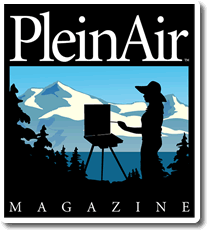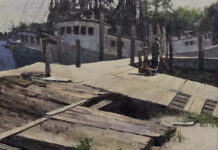Many plein air artists have one simple reaction to digital art: horror. Here’s why they may be wrong.
An application on an iPad or similar tablet allows an artist to create a usable plein air study in 15 minutes. “It’s warp speed,” says noted wildlife artist David Rankin. “What else can you do in that amount of time?” Rankin has sold digital art to collectors, but it isn’t his main focus. He’s an accomplished watercolorist. But he finds that his iPad loaded with the Paper app by the company Fifty Three is an essential tool for field work. “Because you are working so fast, you can try out ideas really quickly,” says Rankin. “If I like something I’ve sketched on my iPad, I can just take my watercolors out and paint it. I take both tools outside.”
Rankin says he can sit outside and carefully choose the colors he sees in the subject matter and mix them on his electronic palette. Then he can take that palette into the studio and have the correct hue and value from which to paint. It’s better than any photograph, and second only to his own sight. “My eyes are my best color assessment tool,” he emphasizes.
The advantages of painting quickly with a digital tool are evident. Rankin recounts the time he painted a snow scene on a very cold day with his iPad. He took the digital sketch into his studio and painted a watercolor from it. Then he shared the digital sketch with 20 of his students, and they all painted from it. Rankin, like other fans of painting apps, says digital painting is no substitute for the real thing. It’s a different beast. “It’s not going to look like oils or watercolor or acrylic,” Rankin says. “It’s going to look like Paper by Fifty Three.”
That’s mostly true. A traditional artist will most likely pick out any digital image. But digital paintings by people like Nop Briex and Chad Greene may not be easily identified as such by the general public. Briex says he uses a tablet when he doesn’t have time to set up and paint a scene — he may see something on his way home from work, and have time to stop for 30 minutes. Greene comes from a background that includes work for Dreamworks Animation, and he currently works on video games for Microsoft, so he unsurprisingly feels very comfortable in the digital world.
“There are a few advantages of digital over traditional media,” says Greene. “I am a believer that nothing is better than using traditional media — the feeling of holding a brush, working with actual paints, and feeling the brush interact with the surface. However, working with digital offers the following advantages: First, it’s like traveling with a sketchbook, but with millions of colors. I take my Surface Pro with me everywhere and can paint on a moment’s notice. The Surface Pro offers me the ability to paint with a pen device that has pressure sensitivity, which is very important and which comes close to being able to mimic traditional media. As mentioned, you have millions of colors from which to choose — and don’t have to struggle with color mixing. The entire color spectrum is available to use, and you can easily adjust hue/color/saturation to your needs. Finally, digital offers the ability to undo your mistakes. How many times have you wanted to go back in time to change something? This actually has a powerful effect, in that it truly allows you to be bold and take chances with colors, brush strokes, etc. If you don’t like what you did, simply undo the history to get back to an earlier state. A few other advantages: You can mix any media, from crayons to oils to watercolors. You can also work in layers, which is how I like to approach my digital paintings, often starting with very loose brushstrokes to block in the image and then creating multiple layers with more detail and texture.”
Digital art is sometimes vilified because it can have a photograph as its basis, with “paint” applied on top of the image to give it the look of a painting, without the need for any drawing or color-mixing skills. It’s hard to defend such pieces as works of art, but this process can make exceptional reference material. Briex sometimes works this way. That doesn’t mean he equates it with actual painting. It’s a learning tool. “Working with the ArtRage software is for me an added value for making quick oil sketches and to understand brushstrokes, detail, focus, and depth — but at the end I prefer a real oil painting,” he says. Briex does sell his digital art, and he can print the piece on canvas and give it texture by applying a transparent gel medium for acrylics made by Royal Talens, using a hog bristle brush.
“I don’t know where all of this is going, but we are pushing the envelope with this technology,” says Rankin. “There’s never been something like this in history. A $600 piece of glass is making all kinds of things happen.”
(Due to the age of this post, some images may be missing from this article)




